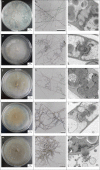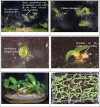Symbiotic seed germination and seedling growth of mycorrhizal fungi in Paphiopedilum hirsutissimun (Lindl.Ex Hook.) Stein from China
- PMID: 38104263
- PMCID: PMC10730140
- DOI: 10.1080/15592324.2023.2293405
Symbiotic seed germination and seedling growth of mycorrhizal fungi in Paphiopedilum hirsutissimun (Lindl.Ex Hook.) Stein from China
Abstract
Similar to other orchid species, Paphiopedilum hirsutissimum (Lindl.ex Hook.) Stein, relies on nutrients provided by mycorrhizal fungus for seed germination and seedling development in the wild owing to a lack of endosperm in its seeds. Therefore, obtaining suitable and specialized fungi to enhance seed germination, seedling formation, and further development is considered a powerful tool for orchid seedling propagation, reintroduction, and species conservation. In this study, we investigated the diversity, abundance, and frequency of endophytic fungal strains in the root organs of P. hirsutissimum. One family and five genera of the fungi were isolated and identified through rDNA-ITS sequencing. The ability of isolated fungi to germinate in vitro from the seeds of this species was evaluated, and the development of P. hirsutissimum protocorm has been described. The findings showed that the treatments inoculated with endophytic fungal DYXY033 may successfully support the advanced developmental stage of seedlings up to stage 5. In addition, scanning electron microscopy (SEM) revealed that the mycelium of this strain began to invade from either end of the seeds up to the embryo, extending rapidly from the inside to the outside. Its lengthening resulted in the bursting of the seed coat to form protocorms, which developed into seedlings. The results showed that DYXY033 has a high degree of mycobiont specificity under in vitro symbiotic seed germination conditions and is a representative mycorrhizal fungus with ecological value for the species. In summary, this strain may particularly be significant for the protection of P. hirsutissimum species that are endangered in China. In the long run, it may also contribute to global efforts in reintroducing orchid species and in realizing in situ restorations of threatened orchid populations.
Keywords: Paphiopedilum hirsutissimum; mycorrhizal fungi; reintroduction; seedling development; symbiotic germination.
Conflict of interest statement
The authors declare that they have no known competing financial interests or personal relationships that could have appeared to influence the work reported in this paper.
Figures









Similar articles
-
Fungi isolated from host protocorms accelerate symbiotic seed germination in an endangered orchid species (Dendrobium chrysotoxum) from southern China.Mycorrhiza. 2020 Jul;30(4):529-539. doi: 10.1007/s00572-020-00964-w. Epub 2020 Jun 19. Mycorrhiza. 2020. PMID: 32562087
-
What role does the seed coat play during symbiotic seed germination in orchids: an experimental approach with Dendrobium officinale.BMC Plant Biol. 2022 Jul 29;22(1):375. doi: 10.1186/s12870-022-03760-0. BMC Plant Biol. 2022. PMID: 35906552 Free PMC article.
-
Isolation and identification of beneficial orchid mycorrhizal fungi in Paphiopedilum barbigerum (Orchidaceae).Plant Signal Behav. 2022 Dec 31;17(1):2005882. doi: 10.1080/15592324.2021.2005882. Epub 2021 Dec 16. Plant Signal Behav. 2022. PMID: 34913407 Free PMC article.
-
Orchid Reintroduction Based on Seed Germination-Promoting Mycorrhizal Fungi Derived From Protocorms or Seedlings.Front Plant Sci. 2021 Jun 30;12:701152. doi: 10.3389/fpls.2021.701152. eCollection 2021. Front Plant Sci. 2021. PMID: 34276753 Free PMC article. Review.
-
Germination and seedling establishment in orchids: a complex of requirements.Ann Bot. 2015 Sep;116(3):391-402. doi: 10.1093/aob/mcv087. Epub 2015 Aug 12. Ann Bot. 2015. PMID: 26271118 Free PMC article. Review.
Cited by
-
Shifts in bacterial community composition during symbiotic seed germination of a terrestrial orchid and effects on protocorm development.Microbiol Spectr. 2024 Nov 14;12(12):e0218524. doi: 10.1128/spectrum.02185-24. Online ahead of print. Microbiol Spectr. 2024. PMID: 39540748 Free PMC article.
-
Core Mycorrhizal Fungi Promote Seedling Growth in Dendrobium officinale: An Important Medicinal Orchid.Plants (Basel). 2025 Mar 25;14(7):1024. doi: 10.3390/plants14071024. Plants (Basel). 2025. PMID: 40219092 Free PMC article.
-
Mycorrhizal fungus BJ1, a new species of Tulasnella sp.: its biological characteristics and promoting effect on seed germination of Bletilla striata.Front Plant Sci. 2025 Feb 21;16:1542585. doi: 10.3389/fpls.2025.1542585. eCollection 2025. Front Plant Sci. 2025. PMID: 40061032 Free PMC article.
-
Comparative transcriptomics and proteomics analysis of the symbiotic germination of Paphiopedilum barbigerum with Epulorhiza sp. FQXY019.Front Microbiol. 2024 Mar 18;15:1358137. doi: 10.3389/fmicb.2024.1358137. eCollection 2024. Front Microbiol. 2024. PMID: 38562471 Free PMC article.
References
-
- Rasmussen HN. Terrestrial orchids, from seed to mycotrophic plant. Cambridge University Press; 1995.
-
- Gao YY, Peng SJ, Hang Y, Xie GF, Ji N, Zhang MS. Mycorrhizal fungus Coprinellus disseminatus influences seed germination of the terrestrial orchid Cremastra appendiculata (D. Don) Makino. Sci Hortic (Amsterdam). 2022;293:110724. doi:10.1016/j.scienta.2021.110724. - DOI
-
- Khamchatra N, Dixon KW, Tantiwiwat S, Piapukiew J. Symbiotic seed germination of an endangered epiphytic slipper orchid, Paphiopedilum villosum (Lindl.) Stein. From Thailand. S Afr J Bot. 2016;104:76–81. doi:10.1016/j.sajb.2015.11.012. - DOI
MeSH terms
LinkOut - more resources
Full Text Sources
